Mastering the Smooth Rider Stabilizer in Kiteboarding
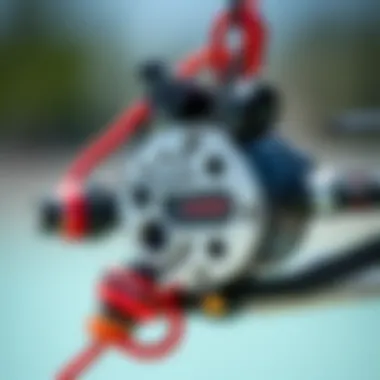
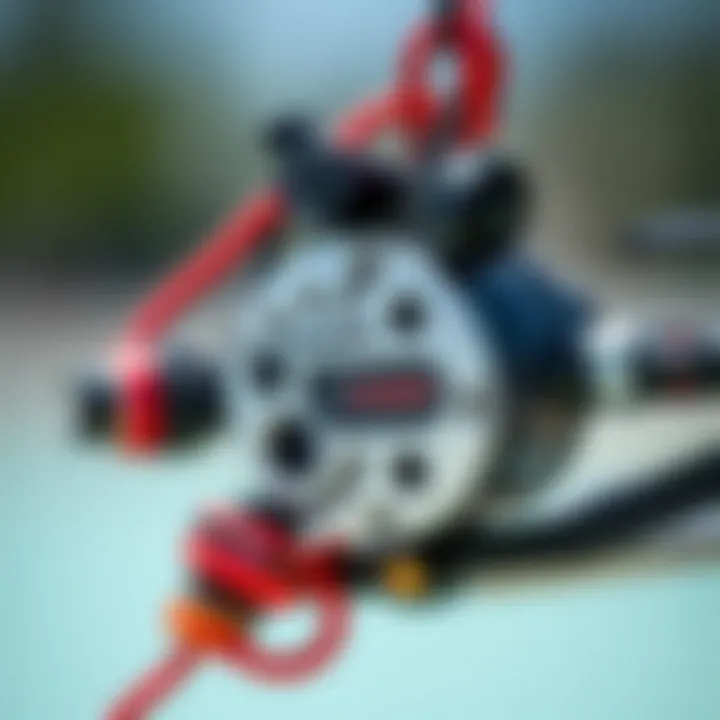
Intro
In the world of kiteboarding, where wind meets water in a dance of freedom and exhilaration, the smooth rider stabilizer emerges as an unsung hero. For many, the thrill of skimming across waves is undeniably appealing; however, the technical aspects that elevate performance shouldn’t be overlooked. The smooth rider stabilizer, often a crucial component, is designed to enhance stability and control, providing riders with a more fluid and enjoyable experience.
As kiteboarding continues to grow in popularity, understanding the sophisticated technologies contributing to a smoother ride is essential for both novices and seasoned enthusiasts alike. This article unpacks the intricacies of the smooth rider stabilizer, shedding light on its role, benefits, gear selection, and key techniques for maximizing the kiteboarding experience. Whether you're a newcomer eager to tackle the waves or a veteran looking for that extra edge, this guide aims to inform and engage.
Gear Selection
Choosing the right gear is paramount in kiteboarding, as it directly impacts your performance and comfort. The right selection not only augments your skills but also enhances the overall riding experience. Let's delve into the key elements involved in gear selection, with a focus on the synergy between kites and boards, particularly in relation to the smooth rider stabilizer.
Types of Kites
When it comes to kites, understanding their varying designs and functionalities can be like deciphering a finely woven tapestry. Here are some popular types:
- Bow Kites: These kites offer efficient power and excellent stability. Ideal for beginners and advanced riders alike, they adapt well to variable wind conditions.
- C-Kites: Favored by freestyle riders, C-kites deliver explosive pop and direct control. They require a bit more skill to navigate but are loved for their performance potential.
- Delta Kites: A perfect compromise, delta kites combine lift and stability. Their versatility makes them suitable for a range of conditions.
Each kite has distinct characteristics, but in relation to a smooth rider stabilizer, a bow or delta kite often pairs well to enhance a consistent ride.
Choosing the Right Board
Selecting the right board adds another layer of importance. Boards come in different shapes, sizes, and materials, affecting how well they handle under varying circumstances. Here are some aspects to consider:
- Board Size: Larger boards provide more stability and better float in low winds. Smaller boards, while less stable, can perform with higher speeds.
- Construction Material: Boards constructed from lightweight materials often enhance maneuverability. A smooth rider stabilizer can further improve this by offsetting wind turbulence.
- Rockers and Shapes: A flatter rocker allows for speed and easy planing, while a more pronounced rocker helps with tricks and turns. The stabilizer enhances these dynamics by ensuring better grip and control.
In summary, your gear serves as the foundation for your kiteboarding journey. Well-chosen kites and boards supplemented by a smooth rider stabilizer can transform your experience, elevating both comfort and skill progression.
Skill Development
With optimal gear in hand, the next step is honing your skills. No matter your starting point, a smooth rider stabilizer plays a complementary role in technique refinement and progression.
Essential Techniques
Mastering key riding techniques lays the groundwork for enjoyment and safety on the water. Here are some essential skills to focus on:
- Body Positioning: Understand how to balance your body weight effectively. Maintaining a low center of gravity helps with stability.
- Edge Control: Learning to manage your edge control can greatly influence the ride. The stabilizer’s function in offering a buffer against turbulence aids in developing this skill.
- Jumping Techniques: As you progress, practicing jumping involves timing and coordination. The stabilizer assists with landing by providing improved stabilization upon impact.
Progression Tips
Every kiteboarder aims to progress, and here are several practical tips to enhance you journey:
- Practice Regularly: Don’t shy away from the water; regular practice solidifies skills.
- Seek Feedback: Learning from more experienced riders can provide insights you might miss on your own.
- Embrace Challenges: Push your boundaries. Attempting new tricks or riding in various conditions can accelerate learning and adaptability.
"The smooth rider stabilizer isn’t just a part of the ride; it’s a partner that resonates with every commitment to the sport."
In the quest for mastering kiteboarding, skill development is as vital as the equipment you wield. By understanding how the smooth rider stabilizer contributes to both skill acquisition and refinement, you position yourself for a much richer kiteboarding experience.
Understanding the Smooth Rider Stabilizer
In the ever-evolving world of kiteboarding, the Smooth Rider Stabilizer has emerged as a crucial component that enhances both performance and safety. For kiteboarders, understanding what this stabilizer is and how it functions can make a world of difference on the water. Not only does it contribute to a smoother ride, but it also plays a vital role in ensuring riders can handle varying conditions with confidence. As any seasoned kiteboarder knows, stability is paramount, and the Smooth Rider Stabilizer aims to deliver that in spades.
Definition and Purpose
At its core, a stabilizer is designed to maintain balance during a ride, especially when faced with gusty winds or shifting sea conditions. The Smooth Rider Stabilizer cushions the movement of the board, allowing it to respond more predictably to the forces exerted by both the rider and the elements. This means that kiteboarders can focus on their tricks, maneuvers, or simply enjoying the ride without being thrown off balance by sudden shifts in wind.
Moreover, the purpose of this stabilizer goes beyond just making the ride smoother. It actively helps to prevent injuries that can arise from falls or jolts caused by unexpected wind changes. A well-designed stabilizer can transform an intimidating experience into an exhilarating one, particularly for new riders who might feel nervous about their control.
Technical Components
Delving into the technical side, the Smooth Rider Stabilizer is typically composed of a series of interconnected structures designed to absorb shock and maintain control. Key components may include:
- Damping Systems: These help absorb vibrations, allowing for more fluid motion.
- Directional Foils: Engineered to enhance stability, these foils play a significant role in guiding the board through turbulent waters.
- Rigid Frame: A strong yet lightweight framework supports all other components, providing structure and preventing flex that could compromise performance.
- Adjustable Settings: Many stabilizers come with customization options, letting riders tweak their setup based on riding style or conditions.
Understanding these components helps riders appreciate the engineering behind their equipment. It’s not just about clever marketing; there’s a wealth of technology at play designed to make kiteboarding as enjoyable as possible.
"In the fast-paced world of kiteboarding, every bit of stability counts. The Smooth Rider Stabilizer offers a unique blend of technology and functionality that truly enhances rider experience."
In essence, knowing how the Smooth Rider Stabilizer works and what it contains empowers riders to make informed choices when it comes to their gear. As kiteboarding techniques and conditions evolve, having an understanding of this stabilizer can make a significant difference to any rider's performance.
The Importance of Stability in Kiteboarding
The element of stability in kiteboarding serves as a cornerstone for both safety and performance. It is the balancing act that distinguishes a good ride from a great one. When kiteboarding, every slight movement can drastically affect a rider’s trajectory and control; this is where stability plays its crucial role. Whether you are a novice soaking in the joy of your first ride or a seasoned veteran looking to conquer the waves, the stability provided by equipment like the Smooth Rider Stabilizer can greatly enhance the kiteboarding experience.
Balancing Performance and Control
Finding the sweet spot between performance and control is imperative for maintaining an enjoyable ride. Kiteboarding invites riders to engage in maneuvers that require solid balance and sharp responsiveness. Consequently, the incorporation of stabilizers contributes positively towards achieving that delicate balance.
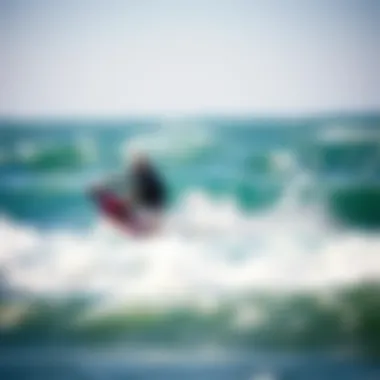
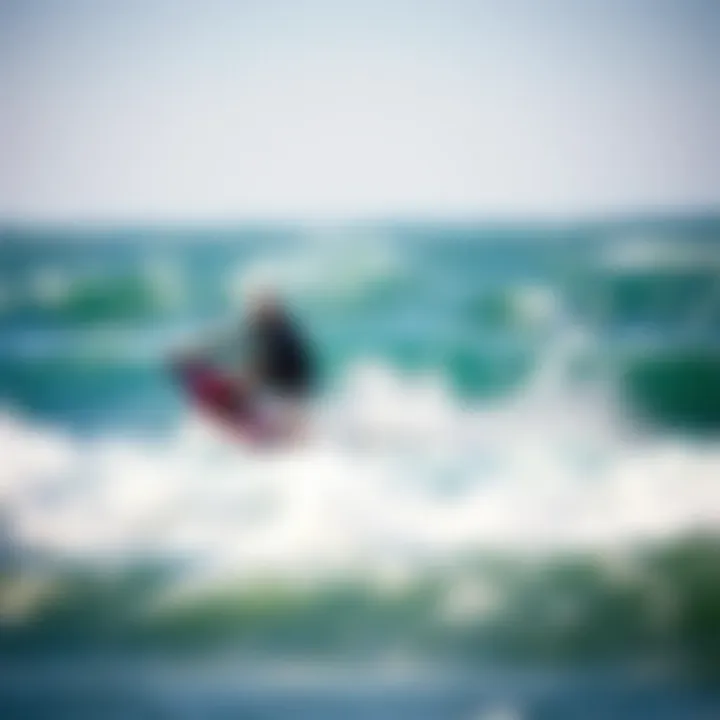
- Performance: In terms of performance, the right stabilizer allows a kiteboarder to push their limits, providing an edge during high-speed turns or jumps. Riders can confidently aim for bigger tricks and longer distances as the stabilizer cushions against unexpected shifts in wind or turbulence while in motion.
- Control: On the flip side, control is what allows riders to feel their environment and respond effectively to the unpredictable nature of wind. A stabilizer that lacks the right features can hinder a rider’s ability to steer accurately. A well-designed stabilizer will not restrict the rider's movements but will enhance their connection to the kite, thus resulting in a fluid riding experience.
Stability minimizes what can be termed as 'white-knuckle moments'—those times when a gust catches you off-guard. With the proper gear, these moments become less daunting, fostering a sense of confidence and empowerment.
Impact of Wind Conditions
Understanding how different wind conditions influence stability is vital. Every seasoned kiteboarder knows that wind can be unpredictable, acting like a capricious dance partner. The Smooth Rider Stabilizer comes into play here, adapting to changing conditions and offering a buffer against the varying forces.
- Mild Winds: In gentler breezes, the stabilizer can harness the wind’s potential and glide smoothly across the water’s surface, allowing for effortless rides. Here, it's not just about getting from point A to point B but savoring the ride itself.
- Strong Winds: Conversely, in stronger winds, a stabilizer plays a pivotal role in maintaining control and stability. During gusts, a kiteboarder’s agility can be put to the test. The stabilizer enables quick adjustments and keeps the rider steady, reducing the risk of falls.
"Wind conditions can truly be a double-edged sword; it's how we wield our equipment that defines our experience.”
The performance of kiteboarders hinges on recognizing how these factors interact. By understanding wind conditions and making informed gear choices, kiteboarders can navigate challenges with greater ease, enhancing their overall experience in this thrilling sport.
How the Smooth Rider Stabilizer Works
Understanding how the Smooth Rider Stabilizer operates is crucial for kiteboarders aiming to improve their performance and safety on the water. This section unpacks the complex mechanics behind stabilization and its influence on rider dynamics, ensuring a smoother, more controlled ride in various conditions.
Mechanics of Stabilization
At its core, the Smooth Rider Stabilizer is designed to enhance stability in the ever-changing environment of kiteboarding. The technology operates through a clever combination of structural designs and materials that adapt to wind changes. When you're zipping across the waves, slight shifts in wind direction can cause instability, leading to a loss of control. This is where the stabilizer steps in.
- Tension and Structural Integrity: The stabilizer uses tensioned lines that connect to the kite and board, ensuring that even when the wind gusts or drops, there is a constant, balanced pull. This is achieved through the use of lightweight, resilient materials such as carbon fiber.
- Dynamic Flexibility: Another critical component is the design’s ability to flex according to the pressure exerted by the wind, allowing for a more natural reaction to changing conditions. This flexibility prevents the board from catching too much air or becoming unmanageable during sudden shifts.
- Weight Distribution: Effective weight distribution is equally essential. The stabilizer ensures that the kite and rider's weight is evenly balanced across the rig. This enhances the rider's center of gravity, making it much easier to maintain stability, especially at high speeds.
The combination of these mechanics allows for a significantly smoother ride, enabling riders to achieve greater speeds without compromising control.
Enhancing Rider Dynamics
The second critical aspect of the Smooth Rider Stabilizer is how it elevates rider dynamics on the water. As advanced as technology can get, the relationship between the kiteboarder and their equipment still relies heavily on the rider’s input and response.
- Responsive Turns: Thanks to the stabilizer, turning becomes more responsive and precise. When a rider initiates a change in direction, the stabilizer facilitates smoother transitions, giving the rider more confidence in their movements.
- Reduced Fatigue: By improving overall stability, the Smooth Rider can also reduce the physical strain on the rider. With less fight against the wind, dynamics feel more natural, allowing riders to focus more on technique rather than merely staying upright.
- Heightened Awareness: Riders equipped with the Smooth Rider find that they develop a finer sense of their surroundings. Because the stabilizer offers consistent feedback through its responsive nature, kiteboarders can better anticipate shifts in the weather and water conditions.
In summary, the Smooth Rider Stabilizer does more than just prevent spills; it fundamentally alters the way riders interact with their environment, promoting enhanced performance and increased enjoyment on the water.
For more insights on the mechanics behind kiteboarding technology, consider checking resources like Wikipedia or engaging with communities on Reddit.
Selecting the Right Stabilizer
Choosing the right stabilizer is a crucial decision for kiteboarders aiming to enhance their riding experience. The right stabilizer can mean the difference between a smooth glide over the water and a frustrating battle with the elements. With a range of products available, understanding what contributes to an ideal choice is essential for both performance and enjoyment on the water. This section will explore the factors that should weigh into your decision-making process and how they can be matched to your riding skill level, ultimately leading to a much better time kiteboarding.
Factors to Consider
When selecting a stabilizer, several factors should be in your decision-makinbg toolkit. It’s not just about picking one out of a paper bag filled with options. The art of selecting the right piece of gear is multifaceted.
- Riding Style: Consider the specific nature of your riding. Freestyle riders may lean towards stabilizers that offer more maneuverability, while wave riders might appreciate models designed for stability in choppy waters.
- Wind Conditions: The average wind speed you usually contend with matters a lot. High winds call for compact and rigid stabilizers, while lighter winds might let you benefit from looser setups.
- Weight and Size of the Rider: Your physical attributes can highly influence how the stabilizer behaves. A lightweight rider may handle a shorter stabilizer well, but this setup may not suit larger or heavier individuals.
- Material Quality: Durability is often overlooked until it’s too late. Look for materials that are both lightweight and robust. Carbon fiber, for instance, often offers superior strength-to-weight ratio.
- Budget: Understand your price threshold. Higher price tags can mean better technology, but there are effective options at various price points. Determine what you can invest for your kiteboarding adventures.
"Choosing a gear is like finding a good pair of shoes; what works for one may not work for another. The right fit is king."
Matching Stabilizer to Rider Skill Level
A crucial aspect of selecting a stabilizer is aligning it with your level of skill. It's akin to picking a paddle for a canoe; you wouldn't use a seasoned sailor's gear when you’re just starting.
- Beginners: For those just taking their first steps in kiteboarding, opting for a stabilizer that offers ultimate stability and forgiveness can set the right tone. A larger, more stable model will help instill confidence during those early challenging gusts.
- Intermediate Riders: As you gain experience, a good next step would be transitioning to a stabilizer that allows for some dynamic movement. This adjustment can enhance your skill set and introduce you to basic tricks. Your stabilizer should maintain some stability while giving you the freedom to explore.
- Advanced Riders: At this level, kiteboarding becomes a balance of finesse and control. A finely tuned stabilizer that specializes in performance can become your best friend. Such choices can include more rigid designs that offer minimum drag and maximum response.
By understanding these factors and how they correspond to your ability, your investment can yield dividends in performance and enjoyment, helping you ride the waves like a pro.
Applications Across Riding Styles
The Smooth Rider Stabilizer finds its significance in a diverse array of kiteboarding styles. Its adaptability is particularly noteworthy, as it enhances performance, providing crucial stability across various conditions and techniques. Whether a rider is performing tricks in the air, riding waves, or aiming for speed, the stabilizer serves as an invaluable asset, ensuring both safety and enjoyment on the water. In this section, we’ll dig into how the stabilizer impacts three prominent riding styles: freestyle, wave riding, and race performance.
Freestyle Riding
Freestyle riding is all about tricks, jumps, and showing off skills. Riders push their limits, often reaching for the sky with insane aerial maneuvers. In this exhilarating pursuit, the Smooth Rider Stabilizer plays a critical role. Its design aids in maintaining balance, allowing riders to focus on their tricks rather than worrying about losing control mid-air. The stabilizer smoothens airflow around the kite, essentially reducing turbulence which can lead to unwanted drops or crashes.
- Reduced Risk of Falls: A stabilizer can make a huge difference in high-stake situations where balance is vital. The extra support ensures that even if the wind shifts unexpectedly, the kite remains manageable.
- Enhanced Trick Execution: With better control, riders can combine maneuvers such as spins or flips more seamlessly. Kites equipped with stabilizers permit a smoother transition during tricks.
- User Feedback: Many freestyle enthusiasts report that their confidence soared when using stabilizers, allowing them to explore new and complex tricks without the constant fear of wipeouts.
Wave Riding
Wave riding introduces a unique set of challenges. Here, the interplay between wind and water becomes much more pronounced, and the Smooth Rider Stabilizer assists riders in navigating these dynamic conditions. The stabilizer helps keep the kite stable, which is essential when riding through choppy waves.
- Improved Handling: The stabilizer provides better responsiveness, allowing riders to make quick adjustments as they tackle waves. This capability is essential for cutting through the water and managing the kite effectively, especially during turns.
- Stability during Downwind Runs: When riding downwind, the waves can create unpredictable movement. A stabilizer grants riders the extra stability required to navigate through these conditions without losing speed or control.
- Feedback from Riders: Many wave riders express that their performance improved notably after adopting stabilizers, highlighting better control during crucial moments, such as navigating through breaks or making sharp turns.
Race Performance
In race performance, every fraction of a second counts. This sport demands not just speed but also precision. The Smooth Rider Stabilizer enhances racing by optimizing aerodynamics and providing that much-needed edge.
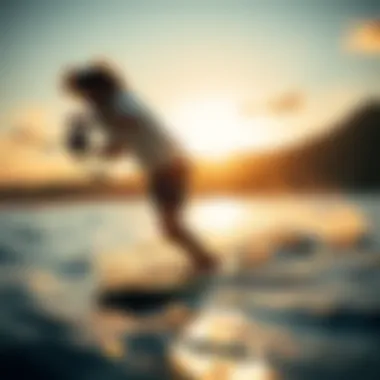
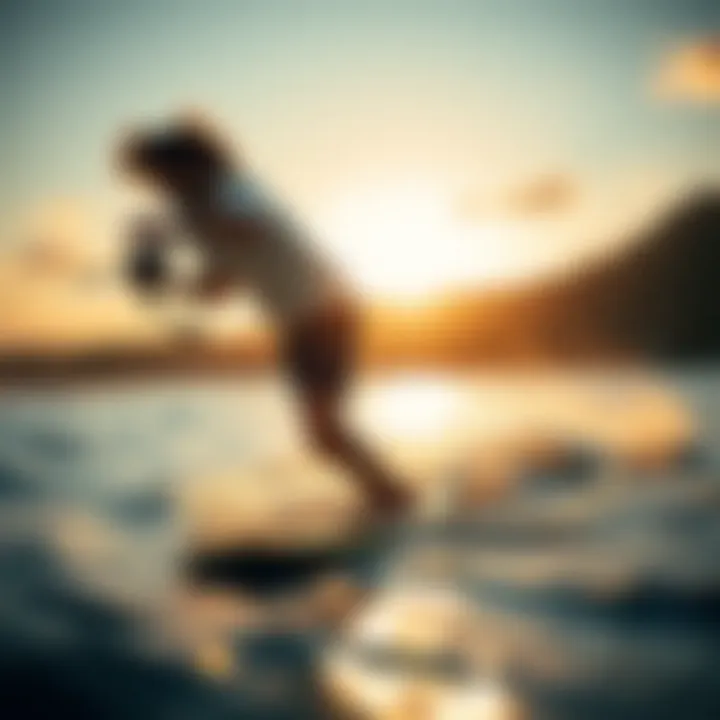
- Speed Optimization: A stabilizer creates a cleaner airflow, which can translate to faster speeds. The reduced drag allows racers to push their kites to the limit without fear of losing control.
- Fine-Tuned Control: During high-speed races, making quick adjustments is critical. The stability offered by the stabilizer allows racers to steer with pinpoint accuracy, even in gusty wind conditions.
- Insights from Competitors: Competitive riders often share that stabilizers helped improve their overall performance. They allow for sharper turns and more calculated maneuvers without compromising speed.
In summary, the Smooth Rider Stabilizer is not just a simple accessory; it's an essential tool that supports kiteboarding across various styles. Riders engaged in freestyle activities can experiment without the constant worry of balance, wave riders gain crucial control over their navigation, and racers find themselves aided by stability and optimized speed. Its application is widespread, and understanding its benefits could mean a world of difference for both novice and experienced kiteboarders alike.
Maintenance and Care for Stabilizers
Maintaining your smooth rider stabilizer is more than just a good idea; it’s crucial if you want to keep your kiteboarding experience comfortable and safe. A well-cared stabilizer not only enhances performance but also prolongs the lifespan of your gear. There are a few key areas to focus on when considering maintenance, including routine checks, cleaning, and storage practices.
Routine Checks and Inspections
Regular inspections should become a habit for every kiter. Taking some time to check the stabilizer can make a world of difference come ride day.
- Visual Inspection: Before heading out, a thorough visual inspection is essential. Look for signs of wear and tear, such as frayed lines or cracks in the stabilizer components. Bumps and scratches might seem minor, but they can affect performance.
- Functional Testing: Give your stabilizer a quick test by pulling on it and checking its responsiveness. This will help ensure all components are functioning correctly. Any strange noises could signal a future issue.
- Check Connectors: It's common for connectors to get loose over time. Make sure they are fastened securely. Loose connections could lead to unexpected failures.
Overall, timely maintenance ensures you can dodge mishaps on the water. Done regularly, these checks help you ride confidently rather than nervously wondering if your gear will hold up.
Cleaning and Storage Practices
When it comes to cleaning your stabilizer, knowledge is power. It’s not just about making it look shiny; it’s about preserving functionality over time.
- Freshwater Rinse: After each session, rinse the stabilizer with freshwater to remove salt, sand, and debris. Salt buildup can damage components over time, so don't skip this step. Even a quick rinse can save you headaches later.
- Dry Completely: Ensure that everything dries properly before storing it away. Putting a wet stabilizer into storage can promote mold and degrade materials.
- Proper Storage: When storing your stabilizer, keep it in a dry, cool place. Avoid exposure to direct sunlight or heat sources, as this can weaken the materials. When in doubt, store it in a padded bag to prevent unnecessary damage.
Storing your gear correctly contributes to its durability, allowing each kiteboarding session to be as thrilling as the last.
"A small effort in maintenance yields substantial rewards in performance and safety."
In summary, maintaining your smooth rider stabilizer involves a blend of vigilance, simple cleaning routines, and proper storage techniques. This approach can vastly improve your artistic endeavors on the water while ensuring your gear serves you well for many seasons. By embedding these practices into your routine, you cultivate not only longevity for your gear but also enhance your overall kiteboarding experience.
Comparative Analysis with Other Stabilization Technologies
In the dynamic and ever-evolving world of kiteboarding, the choice of equipment can significantly impact a rider's experience. The Smooth Rider Stabilizer is one such piece of gear that has garnered attention for its improved stability and control. However, it’s essential to understand how this stabilizer measures up against other stabilization technologies available on the market. By diving into a comparative analysis, we can glean insights that not only elevate our understanding but also inform our choices when gearing up for the waves.
Alternative Stabilizers
When discussing alternative stabilizers, one cannot overlook options like the Flysurfer Soul and the Naish Pivot. Each of these systems utilizes unique methodologies to address stability and control during kiteboarding:
- Flysurfer Soul: This stabilizer focuses on aerodynamic design, offering efficient power delivery and trajectory stability, especially in gusty conditions. It's known for its ability to maintain a steady flight path, making it a favorite among riders who face unpredictable winds.
- Naish Pivot: Utilizing a more traditional setup, the Naish Pivot provides versatile performance suitable for various riding styles. This stabilizer excels in turning responsiveness while providing admirable lift. It’s particularly favored by freestyle riders who need quick maneuverability without sacrificing stability.
Each of these alternatives brings its own flavor, ensuring that riders have choices tailored to their preferences and riding styles. Choosing among them often comes down to personal riding style and desired performance characteristics.
Evaluating Effectiveness
Comparing the effectiveness of various stabilizers can feel like comparing apples to oranges. However, several factors aid in evaluating how well these stabilizers perform compared to the Smooth Rider Stabilizer. Here are some key aspects to consider:
- Stability: How well does the stabilizer keep the kite steady in varied wind conditions? The Smooth Rider Stabilizer often showcases superior stability, reducing the likelihood of unintended dips and dives.
- User Comfort: A stabilizer should not only enhance performance but should also feel good underfoot. Riders often report that the Smooth Rider provides a more comfortable ride, especially over long sessions.
- Durability and Maintenance: The materials and construction methods used can determine how long a stabilizer will last, especially when exposed to the salty sea air and intense sun. Riders generally find that Smooth Rider holds up well over time, requiring less maintenance than its counterparts.
- Performance Feedback: Finally, user testimonials give valuable insight into real-world application. Many riders, both novice and seasoned, favor the Smooth Rider for its intuitive handling, particularly in tricky conditions.
In summary, while various stabilizers offer unique strengths, understanding their effectiveness across different parameters is crucial for kiteboarders looking to enhance their experience. By comparing these technologies, riders can tailor their gear choices to achieve optimum performance, adapting their approaches according to personal preferences and riding conditions.
"The right stabilizer can be the difference between flying high and crashing down."
For further information on stabilization technologies and gear comparisons, you can explore resources like:
In navigating through the variety of stabilizers, kiteboarders can find what aligns with their skills and ambitions, ensuring a thrilling ride on the waves.
User Experiences and Testimonials
When it comes to understanding the true impact of the smooth rider stabilizer in kiteboarding, the voices of users cannot be overlooked. Real-world experiences not only highlight the functionality of the stabilizer, but also its plausible benefits and challenges faced by riders in various scenarios. Testimonial accounts may vary widely, but they consistently reveal key insights that can guide both beginners and seasoned enthusiasts in their decision-making processes.
Here, we delve into two distinct perspectives: beginner insights and advanced rider feedback, showcasing how varied experiences contribute to a more rounded understanding of the stabilizer's role in enhancing performance, safety, and overall enjoyment in kiteboarding.
Beginner Insights
For newcomers to kiteboarding, the learning curve can be somewhat steep. Many beginners discover that the smooth rider stabilizer makes that initial leap into kiteboarding significantly more manageable. One common sentiment shared among novices is that this stabilizer grants them a notable cushion during their first experiences on the water. The increased stability can make the kite feel less daunting and more forgiving.
A first-time rider from Florida shared, "I was terrified of crashing my kite. The smooth rider stabilizer gave me a sense of security. I felt like I could try more without wiping out constantly." This kind of feedback underscores the stabilizer’s purpose of providing stability, especially under varying wind conditions. Additionally, many beginners emphasize that having a stabilizing tool makes them feel more in control, allowing them to concentrate on mastering basic techniques.
However, it is also important to note that some beginners feel they might become too dependent on such technology, possibly delaying their skill progression. As one enthusiast put it, "Sure, the stabilizer helped me, but sometimes I wonder if I relied on it a bit too much." This awareness can serve as valuable guidance for those fresh to the sport - recognizing that while stabilizers enhance safety, growth as a rider may involve a balance between technology and personal skill development.
Advanced Rider Feedback
On the flip side, advanced riders often share a different perspective when it comes to the smooth rider stabilizer. For seasoned kiteboarders, who are familiar with the nuances of the wind and have developed substantial technical skills, the attributes they praise are often more about performance enhancement rather than dependency.
One experienced rider from California stated, "The smooth rider makes it easier to execute tricks. It feels like having an extra layer of support when I’m pushing the limits of what I can do. It allows me to focus on my moves without constantly worrying about balance issues." This sentiment illustrates how advanced riders leverage the stabilizer not just for safety, but also for maximizing their potential on the water.
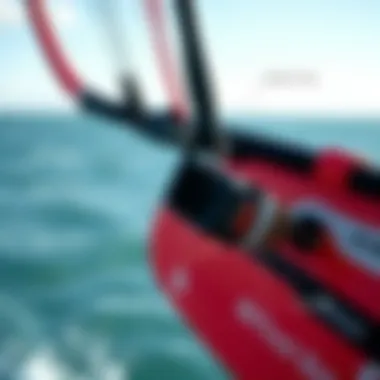
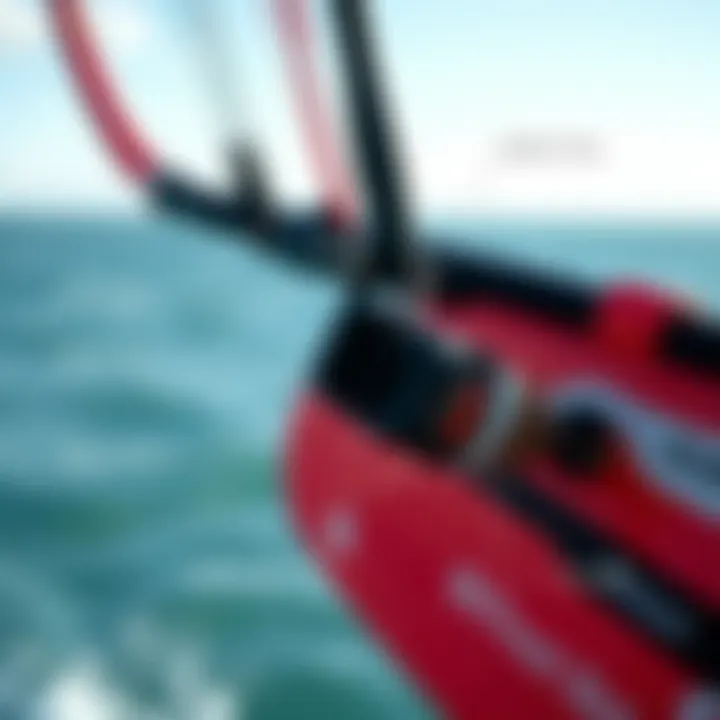
That being said, not all advanced kiteboarders are strictly in favor of using stabilizers. Some feel that they can inhibit a rider's natural responsiveness to the board, making it challenging to adapt quickly to changes in conditions. One pro mentioned, "I prefer going solo most of the time. Stabilizers can be a crutch sometimes; I want to feel every little gust and shift of the wind. But I see the appeal for people who are still honing their skillset."
In summary, the user experiences regarding the smooth rider stabilizer showcase the variance in how this technology is perceived across skill levels. Beginners lean heavily on it for support and confidence, while advanced riders often view it as a tool for fine-tuning performance rather than a necessity. Collectively, these testimonials provide valuable insights into the evolving role of technology in sport, enabling users to make informed choices about their gear and riding journey.
"The right equipment can elevate your ride; sometimes, it’s precisely what you need to discover your true potential on the water."
For further exploration of user experiences in kiteboarding, consider checking online forums on Reddit, or exploring detailed testimonials on platforms like Kiteforum.com.
References for more information:
- Wikipedia - Kiteboarding
- Kiteforum - Community Forum
- Britannica - Kiteboarding Overview
- Reddit - Kiteboarding Discussions
Future Developments in Stabilization Technology
In the fast-paced world of kiteboarding, staying ahead of the curve is vital. Future developments in stabilization technology promise to revolutionize how enthusiasts experience this thrilling sport. These innovations not only enhance rider performance but also prioritize rider safety and comfort. With technology evolving rapidly, understanding what's on the horizon equips kiteboarders with the insights needed to make informed choices about their gear.
Innovations on the Horizon
New designs are already making waves in the kiteboarding scene. From advanced materials to smart technology, developments are embracing a holistic approach to performance. Here are some key innovations to watch:
- Dynamic Wing Adjustment Systems: Imagine a stabilizer that adjusts its shape and tension based on wind conditions. This feature could maintain optimal performance regardless of changing environments, maximizing rider control.
- Integrated Sensors: Technology is encroaching on the action. Sensors that monitor wind speed, direction, and rider performance can provide real-time data. Riders equipped with this data can make prompt adjustments, translating to finer control and smoother rides.
- Eco-Friendly Materials: As environmental concerns grow, manufacturers are exploring sustainable materials that don’t compromise on quality. Using recycled fibers or biodegradable compounds allows kiteboarders to reduce their ecological footprint while enjoying their sport.
These innovations indicate a shift from traditional approaches to a more adaptive technology that caters to the needs of every rider, whether tackling challenging waves or racing across open waters.
Implications for the Sports Community
The implications of these developments stretch beyond individual riders. As the kiteboarding community embraces advanced stabilization technology, the impact resonates through various avenues:
- Increased Participation: Easier and safer riding encourages those who may have felt hesitant to give kiteboarding a shot. When technology makes the sport more accessible, everyone stands to benefit from a growing community.
- Improved Safety Standards: Innovations that enhance stability and control can contribute to a decrease in accidents. As gear becomes more reliable, the sport can shed its reputation for being overly risky.
- Collaboration and Knowledge Sharing: Innovations often lead to discussions among riders, brands, and developers. Sharing insights encourages collaboration which can yield richer experiences, refine technology, and inspire new ideas.
"As technology evolves, the kiteboarding community must adapt to stay relevant and continue fostering passion for the sport."
The future of stabilization technology in kiteboarding is not just a matter of creating better gear. It encompasses a larger vision of collective growth, safety, and environmental responsibility. With this forward momentum, kiteboarders can look ahead to a more vibrant and dynamic sport.
Environmental Considerations in Gear Production
In the world of kiteboarding, the thrill of gliding across waves under the power of the wind is unmatched. However, this electrifying sport does not come without its share of environmental implications. Understanding the nuances of gear production—specifically for the smooth rider stabilizer—is vital. Not only does it contribute directly to the sustainability of kiteboarding practices, but it also affects the health of our oceans and the ecosystems that reside within them. This section aims to explore the essential aspects of environmental considerations in the production of kiteboarding gear, particularly focusing on the stabilizer.
Sustainable Materials
When it comes to crafting kiteboarding gear, using sustainable materials is becoming a necessary principle for manufacturers. Many traditional materials pose threats to the ecosystem and include elements that are non-biodegradable. Kiteboarding stabilizers typically utilize materials such as recycled plastics, organic cotton, and even bio-based resins. These materials not only reduce the reliance on virgin resources but also mitigate waste.
- Benefits of using sustainable materials:
- Lower environmental footprint: Reducing dependence on harmful materials helps lower pollution levels.
- Long lifespan: High-quality sustainable materials often increase the durability of gear, leading to less frequent replacements.
- Rider responsibility: By choosing eco-friendly gear, riders are making a statement, supporting a shift toward responsibility in the sporting community.
Additionally, brands are working towards transparency in their supply chains, ensuring that every element of the stabilizer, from its design to the sticker on it, comes from sustainable resources. This means kiteboarders can enjoy their sport without burdening the planet.
"The choice of materials is more than a decision; it's a commitment to our environment and future generations."
Impact on Kiteboarding Ecosystems
The production of kiteboarding gear does not merely stay confined to the factory; it extends to the ecosystems where these sports take place. Improper production processes can lead to water pollution and habitat destruction, which directly impacts marine life. For example, the runoff from factories can lead to plastic pollution in ocean waters, affecting everything from fish populations to larger marine mammals.
When companies commit to environmentally conscious manufacturing, they contribute positively by preserving these vital ecosystems. They also foster a culture of respect among the kiteboarding community. Practicing kiteboarding means enjoying nature, and what better way to honor that pleasure than to ensure that the keystones of these ecosystems remain intact?
- Considerations in producing kiteboarding gear:
- Avoiding toxic chemicals: By steering clear of harmful substances during the production of stabilizers, companies can help in reducing environmental hazards.
- Water management: Effective handling of water during production minimizes waste and conserves this precious resource.
- Ecosystem education: Encouraging kiteboarders to understand local ecosystems can lead to more responsible riding practices that protect marine environments.
Finale
In summing up the intricate details about the Smooth Rider Stabilizer, it becomes clear that this gear plays a pivotal role in the kiteboarding experience. The stabilizer does not just enhance performance; it fundamentally shifts how kiteboarders interact with the water and the wind. When we look at the stability that the Smooth Rider offers, we find numerous benefits that can uplift not just individual performance but also the overall enjoyment of the sport itself.
From beginners who are still finding their feet, to seasoned pros looking for that extra edge, the stabilizer caters to a wide array of needs. It allows kiteboarders to harness the full potential of their kites, even in challenging wind conditions. The beauty of the Smooth Rider lies in its ability to bridge the gap between various riding styles. Whether one is engaged in freestyle, wave riding, or racing, the stabilizer’s adaptability proves advantageous.
Moreover, this article emphasizes the need for informed choices when selecting stabilizers for kiteboarding. It’s crucial to understand the dynamics of this piece of equipment, as it can drastically impact performance and safety. Approaching gear selection without thorough knowledge can lead to dissatisfaction or even safety issues. Hence, the significance of the conclusion here is to not only summarize but to accentuate the importance of awareness and knowledge in making these choices, which in turn enhances the overall kiteboarding experience.
Summary of Insights
The insights gathered through our exploration of the Smooth Rider Stabilizer illuminate several key aspects:
- Functionality: The stabilizer's core purpose is to provide enhanced stability, which is essential across various riding conditions. This functionality is elemental for both learning and mastering kiteboarding.
- Adaptability: Different riding styles and skill levels require unique stabilizer attributes. The Smooth Rider accommodates these variations, making it a versatile choice.
- Maintenance: Regular care and maintenance are vital for ensuring optimal performance. Understanding how to inspect and clean your stabilizer extends its lifespan and reliability.
- User Perspective: Gathering testimonials from both beginners and advanced riders sheds light on real-world effectiveness and satisfaction.
Recognizing these elements arms kiteboarders with knowledge and a clearer understanding of what stabilizer to choose, effectively enhancing their overall experience on the water.
Encouragement for Informed Choices
In kiteboarding, informed choices can make all the difference between a smooth ride and a troubling experience. When deciding on a stabilizer, consider the following:
- Personal Skill Level: Beginners should opt for stabilizers that offer maximum stability, while advanced riders might look for those that allow for more technical maneuvers.
- Unique Riding Style: Identify the type of riding you enjoy most. Freestyle, wave riding, or racing all demand different attributes from a stabilizer. Choose one that aligns with your preferred style.
- Thorough Research: Before making a purchase, spend time comparing different models. Websites like Wikipedia, and Reddit can provide valuable insights and discussions from the kiteboarding community.
- Ask Professionals: Seek advice from instructors and fellow kiteboarders. Their experiences can guide you toward making the right decision.
Ultimately, ensuring that you are well-informed empowers you to optimize your kiteboarding experiences and enhances not only your enjoyment but also your skills on the water.















